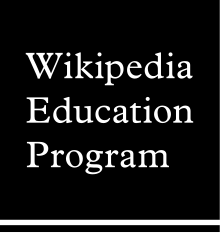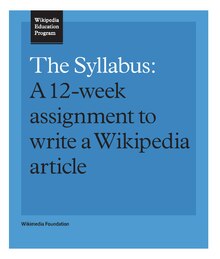The Essentials education brochure/pl

This is text of the Wikipedia Education Program brochure The Essentials: What to do before the term starts from the US/Canada program's Spring 2014 edition.
text
page 1 (cover)

The Essentials: What to do before the term starts
Wiki Education Foundation
Wiosna 2014
page 2 column 1
Witamy w Programie Edukacyjnym Wikipedii!
We’re excited to work with you this term as your students contribute to Wikipedia. This brochure includes some collected best practices and advice from the experiences of professors who have used Wikipedia as a teaching tool in the past. If you have any questions, reach out to the Wiki Education Foundation staff at:
contact@wikiedfoundation.org.
Consult relevant materials
Online Orientation: Wikipedia as a Teaching Tool

All instructors are highly encouraged to complete the online orientation for educators before planning a syllabus. It will introduce you to the culture and rules of Wikipedia, demonstrate the basics of editing, and walk you through a typical Wikipedia assignment like this one.
Podręcznik nauczyciela: Jak używać Wikipedii w pracy dydaktycznej

This brochure covers key Wikipedia policies and structure you’ll need to understand, best practices on article selection and working with the community, and sample grading structures.
http://education.wikimedia.org/instructorbasics
Case Studies: How professors are teaching with Wikipedia

Fifteen professors from six countries are featured in this brochure, as each explains how he or she used Wikipedia in the classroom or how he or she graded the assignment. The web version of the brochure includes links to syllabi and assignment handouts.
http://education.wikimedia.org/casestudies
The Syllabus: A 12-week assignment to write a Wikipedia article

A week-by-week explanation of how to incorporate a “write a Wikipedia article” assignment into your classes. It includes key milestones for ensuring that students derive the greatest educational benefits from editing Wikipedia. See it at
http://education.wikimedia.org/syllabus
The Essentials
page 2 column 2
Talk with your Ambassadors
Each professor works with Wikipedia Ambassadors differently, so it’s important to establish who will be taking on what role in your class before the term starts. If your Campus Ambassador is experienced with editing Wikipedia, he or she may be able to handle many of the on-wiki responsibilities; if not, you should find an Online Ambassador to work with your class. You can contact any available Online Ambassador listed at http://enwp.org/special:OnlineVolunteers and ask him or her to assist with your class.
Here are some tasks you and your Ambassadors will take on throughout the term. We encourage you to meet with your Online and Campus Ambassador as early as possible to make sure you are all clear on who is responsible for what.
› Finalize your assignment design with input from your Ambassadors about what works well on Wikipedia
› Create course page on Wikipedia (see next section for more information)
› Teach students the basics of Wikipedia editing, either in class or in an out-of-class lab
› Teach students about copyright violations and appropriate, reliable sources
› Confirm that all students have created user accounts, edited their user pages, and have enrolled on your on-wiki course page
› Check that all students have gone through the online orientation at http://enwp.org/WP:STUDENT
› Approve student article topics for notability and available scholarship
› Answer students’ Wikipedia questions
› Review students’ work for accuracy and Wikipedia policy adherence
› Serve as a liaison between the class and the Wikipedia community of editors
page 3 column 1
Finalize your assignment design
The reference materials discussed in the previous section should give you some ideas about your Wikipedia assignment. Here are a few important points to consider as you finalize your assignment design.
Współpraca
Do you want your students to work individually or in groups? Wikipedia assignments tend to take students longer to complete than traditional projects, so many professors choose to have students work in groups instead. The MediaWiki software makes it easy to collaborate on an article; each student has his or her own username, and the view history tab will allow you to see which student contributed which sections to the overall article. Instructors who assign students to work individually often add a peer review component to their syllabus to encourage students to collaborate with each other through a peer review process instead.
We also strongly encourage you to try editing Wikipedia yourself. Completing the assignment you’ve designed for your students will give you a feel for the amount of time it takes and how steep the learning curve may be for your students. Many professors end up working with students on articles as well, either by making edits to the article or by leaving suggestions for students on talk pages. The more you’re able to engage with your students on Wikipedia, the deeper they will delve into the subject matter and the collaborative process.
One other potential avenue for collaboration with other editors is by connecting your work to a WikiProject. Many disciplines have an informal group of editors who care about articles related to those topics who self-organize as a WikiProject, and these editors may have good suggestions for which articles in your discipline students could improve. Ask your Ambassador for help finding a related WikiProject.
Brudnopisy
The syllabus referenced earlier lists some pros and cons of students working in sandboxes or the live article namespace. While sandboxes provide a safe space for students to develop their work and offer you a chance to easily see what they’ve done, sandboxes also deny students the experience of collaborating with other editors and seeing their work go live immediately. In general, we recommend that if students are starting new articles, a sandbox can be useful for the first week or so of a student’s work, but once the student has written a few paragraphs (with proper, reliable citations), we recommend moving students’ work into the live Wikipedia article namespace. If students are revising existing articles, we strongly encourage this to happen live rather than using sandboxes, since they should be working from the existing content and engaging with the article’s other editors.
page 3 column 2
Advanced students
You may have heard of Wikipedia’s article quality ratings and review processes, such as “Good Article” designation, or a placement on Wikipedia’s main page in the “Did You Know” section. These community processes are a way to receive feedback on student work, but they require advance planning to ensure there is enough time between when students submit their articles to these processes and the end of the term. Here are some general guidelines for each:
Did You Know: Time is of the essence for Did You Knows, as contributors must nominate their articles to the Did You Know section within five days of having either created a new article or expanded it five-fold. Instructors have found that students get extremely excited by the fact that their work appears on Wikipedia’s main page, but too many student articles at once can overwhelm what is a small, volunteer-run review process. We encourage you to work with your Ambassadors to nominate the best student articles for Did You Know. Students whose articles are nominated for Did You Know will need to be available on-wiki to make edits and respond to questions. See the handout linked from the syllabus for more on Did You Know submissions.
Good Article: The Good Article designation is something that only a small fraction of articles have received on the English Wikipedia, and it is an indication that the article is of top quality. In the Good Article process, a contributor will nominate their article for a Good Article review. The review can take up to a month for a volunteer to do, so you have to factor this time into your syllabus if you encourage students to strive for Good Articles. The review is akin to a peer-reviewed journal review; students should anticipate making changes large and small to their article as a result of the review.
Professors who have had success with using Good Articles often do so when the assignment is a group one (meaning that since students’ individual contributions are less, they have completed the article early in the term), or when Good Article is used as an extra credit opportunity for truly gifted and motivated students. Be sure you’ve reviewed any Good Article submission, and only nominate the best articles so as not to waste volunteer time with articles that don’t meet the requirements. Ask an Ambassador for more information if you want to have your best students participate in the Good Article review process.
The Essentials
page 4 column 1
Set up your course page
To set up a course page, you need to have a user account that has been given the “Course instructor” rights on Wikipedia. Your Regional Ambassador should assign the rights to your account, so be sure to let the Regional Ambassador know your username.
1. Check to see whether your institution is already in Wikipedia’s course page system by going to Special:Institutions. If not, add it. (If you are logged in and have the “Course instructor” rights, you should see an “Add a new institution” section above the list of institutions already in the system. If you don’t see that, contact your Regional Ambassador.)
2. Go to your institution page, then start your course page. In the “Add a course” section, select your institution from the pulldown menu, enter the course name and the term (e.g., Spring 2014), and click “Add course.”
3. Fill in the details for your course including an enrollment token that your students will use as the code to allow them to enroll on the course page, the start and end dates, and a description of the course in general and what students will be trying to do on Wikipedia in particular—and then press “Submit” to create the course page.
After your course page has been started, you can send your students the URL of your course page along with the password and they can sign up as students in the course (once they have created their Wikipedia accounts). You can then use the Courses page (linked from the top of the page near your username) to see recent activity from your students.
The Essentials
page 4 column 2
By participating in the Wikipedia Education Program, you’ve joined hundreds of professors in countries worldwide who see the value in teaching students how to contribute to Wikipedia. We hope you and your students have a good experience using Wikipedia as a teaching tool this term. If there’s anything more we can help you with, please don’t hesitate to reach out. We look forward to seeing what your students produce!
All images from the Wikimedia Commons are under a CC-BY-SA or public domain license unless otherwise stated. The content contained within is available under the Creative Commons Attribution-ShareAlike License v.3.0 (http://en.wikipedia.org/wiki/Wikipedia:CC-BY-SA) or any later version.

The trademarks and logos of the Wikimedia Foundation and any other organization are not included under the terms of this Creative Commons license. Wikimedia Foundation, Wikipedia, Wikimedia Commons, MediaWiki, Wiktionary, Wikibooks, Wikisource, Wikinews, Wikiquote, Wikiversity, Wikispecies, Wikidata, Wikivoyage, and Meta-Wiki are pending trademark registration or are registered trademarks of Wikimedia Foundation.
For more information, please see our Trademark Policy page, http://wikimediafoundation.org/wiki/Trademark_Policy.
For other questions about our licensing terms or trademark policy, please email legal@wikimedia.org
